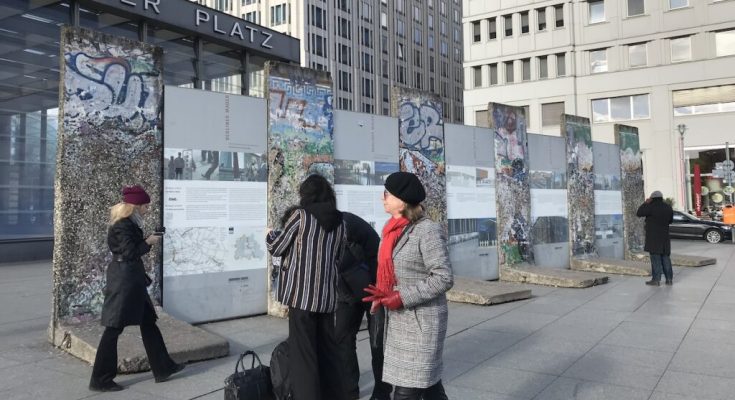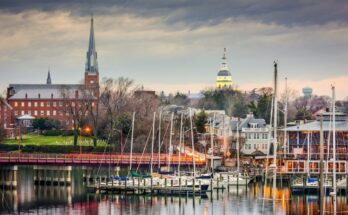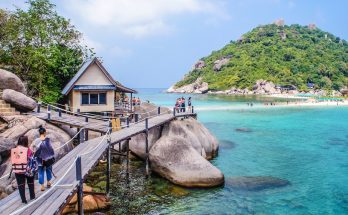I lived in Berlin for six months as part of a study abroad program, and it’s been one of my favorite European cities to visit ever since. It’s vibrant, easy to explore, friendly, and inclusive. Open-mindedness is at the forefront of this German city’s culture.
Berlin is one of those places where history and the future seem to merge seamlessly. For the past century, the city has been the center of modern Europe, playing a leading role in both the Cold War and World War Two.
Somehow, even as history echoes through the streets, Berlin simultaneously embraces a progressive future. Add this all together, and you will find one of the most tourist-friendly and interesting cities to visit in Europe.
Visiting Berlin but not sure where to start? From planning your trip to ironing out your itinerary, I’ve put together this short guide of all the top tips and recommendations I collected over my time spent in the city.
Explore the City By Bike

If you’ve read any of my blogs, you’ll know how much I like to explore a new city on foot. While Berlin is great for walking, the city is pretty enormous, covering 344 square miles of urban and forest landscape.
For this reason, I recommend hopping on a bike and cycling your way through the city—especially if you want to see as much as possible in a short time frame. Companies like LimeBike and Donkey Republic offer bike rentals and allow you to explore the city like a local.
Pro Tip: start your journey around Alexanderplatz and pedal towards the Brandenburg Gate, passing Museum Island and Tiergarten Park along the way.
Check Out the Street Art

Someone once said that “Berlin is a city that never stops reinventing itself, with a story on every corner and every street”. If there is one way to experience Berlin’s cultural secrets, it’s through its street art.
The East Side Gallery is undoubtedly the most famous place to view street art. Artists have sprayed the remnants of the Berlin Wall, and along this long stretch of wall, you can check out hundreds of murals that offer a profound insight into the city’s history and culture.
Pro Tip: Other great neighborhoods for street art include Kreuzberg and Friedrichshain. You can join a guided street tour for under $20 to get a deeper understanding of the art and artists that shape Berlin’s street art scene.
Public Transport is Safe, Efficient, and Affordable

One thing I love about Berlin is its efficient transport system. The main train networks include a subway called the U-Bahn and an overground train called the S-Bahn. Both interlink with one another and offer an extensive route throughout the city and surrounding neighborhoods.
Buses and trams are available within the city center and around the outskirts. The city is divided into three fare zones, with AB including the urban center. A single journey in AB costs €3.50. A short trip of less than three stops on the U or S—Bahn costs €2.40.
If you’re in town for a while, consider getting a 24-hour single ticket for €9.90 in zone AB or a seven-day ticket for €41.50.
Pro Tip: Buy your ticket using the free BVG app. Alternatively, you can get them at a ticket machine on S and U-Bahn platforms or directly with bus drivers. Before your journey starts, you must validate your ticket at a yellow or red box on subway platforms or inside a tram or bus.
Eat at the Zoologishche Garten

The Zoolische Garten is both a transportation hub and a culinary hotspot. Just across the road from the U-Bahn station, you’ll find the Bikini Berlin Mall, with a food court offering tons of dining options.
Meals range from gourmet dishes to quick dash-and-dine meals starting as low as €5 per meal.
I loved eating a quick and cheap lunch at the food court (called the Kantini) here, which overlooks the Berlin Zoo through huge glass windows. One of my favorite restaurants was Bibimix, which sold delicious authentic Korean food like pop chicken and pho.
No visit to Berlin is complete without trying currywurst with fries—a local sausage smothered in curry ketchup. Most stores have vegan options, too.
Sundays are Berlin’s Day of Rest

Before you plan your itinerary, it’s helpful to know that most shops are closed on Sundays. This is the day when Berliners slow down and relax before the new week. While you might not be able to hit the mall or go to your favorite restaurant, the city does have a ton of outdoorsy activities, parks to visit, and flea markets to find unique objects.
Take the time to reset and relax in a park with a good book, or stroll the city on foot on Sundays. Most museums and cultural sites remain open on Sundays and close on either Mondays or Tuesdays instead.
The City is Bigger than Maps Make it Out To Be

As mentioned, Berlin is a sprawling city, with each neighborhood offering a totally unique atmosphere and vibe. For example, a journey from Charlottenburg to the city’s eastern end in Friedrichshain will take about forty minutes by train.
This means planning your routes well and using public transport efficiently to make the most of your time is important.
Visit Off-Peak Seasons

It’s no secret that Europe becomes extremely busy during the summer months. While Berlin doesn’t draw the same beach and mountain crowds as Southern Europe, the city attracts hordes of tourists mainly between May and September.
I recommend visiting in the shoulder season, around April or October. The weather is still pleasant, and all the city attractions are less crowded. On top of this, you’re more likely to find better accommodation deals during these months.
Berlin’s Museum Island is a Must-See

If you’re a culture and history buff like me, Berlin’s Museum Island is a little piece of educational heaven. Located on an island on the Spree River, Museum Island is a UNESCO World Heritage Site that houses five world-famous museums displaying everything from classical art to ancient artifacts from Egypt.
The museums include The Pergamon Museum, featuring the reconstructed Ishtar Gate of Babylon; Alte Nationagalerie (Old National Gallery), with a world of art and architecture from 19th-Century Europe; Altes Museum (Old Museum) with a range of Greek, Roman, and Etruscan artifacts; The Bode-Museum with Byzantine Art and a coin collection that will make you want to become a collector yourself; and the Neues Museum (New Museum), which houses the bust of Queen Nefertiti and other Eqyptian collections.
Pro Tip: Visiting all museums in one day can be overwhelming, so I suggest choosing three and spending an entire day here. You can purchase a day ticket for all five museums for €24 per adult.
For Second-Hand Boutiques, Head for Friedrichshain

Berlin is famous for quirky art, fashion, and culture. If you want to see what I mean by this, I recommend walking around Friedrichshain, a neighborhood that offers a treasure trove for thrifters. Some of the best boutiques include VEB Orange and Humana, selling vintage finds at affordable prices. I found a ton of great items for less than €20.
Take Time to Visit Holocaust Memorials and Museums

With Berlin’s interesting history comes a dark past. When you visit the city, it’s important to pay tribute to those who lost their lives during WW2 and the Holocaust. There are countless memorials and museums dedicated to the war in Berlin.
The most famous include the Memorial to the Murdered Jews of Europe beside the Brandenburg Gate, the Topography of Terror Museum, and the Jewish Museum Berlin.
Explore some Bookstores

If you love to read, Berlin has some epic bookstores worth strolling through. Dussmann is my personal favorite, with an entire floor dedicated to English books and long hours that open until midnight most evenings.
Other cool spots include Marga Scholler, Bucherbogen, which is located under the tracks of the S-Bahn in Savignyplatz, and the Literaturhaus Bookshop, with an adjacent garden cafe.
Berlin Still Has a Strong Cash Culture
Bring along cash, as some small vendors and shopkeepers prefer to trade in euros than with cards.
Day Trip to Potsdam

If you’re up for a day trip, visiting Potsdam is well worth the journey. The city is just a 30 to 40-minute train ride from Berlin and has a totally unique atmosphere. Potsdam is one of the most historic parts of Germany, with palaces, gardens, and historic architecture scattered throughout the city. In fact, these parks and palaces are Germany’s largest World Heritage Site.
Visit Sanssouci Palace, the former residence of Frederick The Great, and explore the elegant Dutch Quarter. The Cecilienhof Palace was the location of the Potsdam Conference, which took place between the allied countries after the end of WW2. A train ticket costs around euro 15 in each direction.



